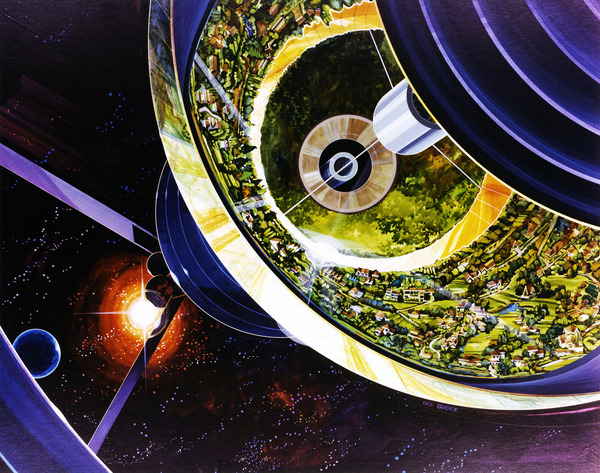This article explores: The economic feasibility of Bernal Spheres for space tourism and industry. Find out more about The Economic Feasibility Of Bernal Spheres.
The concept of Bernal Spheres, first introduced by John Desmond Bernal in 1929, has been a topic of interest for space enthusiasts and scientists for decades.
A Bernal Sphere is a hypothetical space habitat that could potentially provide a self-sustaining environment for humans to live and work in space.
As space exploration and commercialization continue to expand, the idea of Bernal Spheres is becoming increasingly relevant.

One potential application of Bernal Spheres is space tourism, which could offer a unique and exciting travel experience for adventurous individuals.
Additionally, Bernal Spheres could support various aspects of the space industry, including long-duration habitation, resource utilization, and space manufacturing.
However, the economic feasibility of constructing Bernal Spheres for these purposes remains uncertain.
In this paper, we will explore the economic considerations of Bernal Spheres for space tourism and industry, examining potential revenue streams, cost factors, and funding options.
By analyzing the economic feasibility of Bernal Spheres, we can better understand the potential of this concept for the future of space exploration and commercialization.
What Are Economic Factors To Consider In The Production Of Bernal Spheres?
The economic viability of a Bernal sphere would depend on careful planning and management of costs and revenue sources.
While the initial investment may be significant, the potential benefits of space colonization could make it a worthwhile investment in the long run.
The production of Bernal spheres would require significant investment in infrastructure, materials, and technology. Here are some of the economic factors to consider:
Construction costs:
Building a Bernal sphere would require a significant investment in materials and construction equipment. The construction process would be complex and time-consuming, which could also increase the overall cost.
Energy costs:
A Bernal sphere would need a constant supply of energy to maintain a sustainable environment. The energy requirements could be met through renewable energy sources such as solar power, but this would also require an initial investment in infrastructure.
Resource management:
A closed environment like a Bernal sphere would require careful management of resources such as food, water, and air. Developing sustainable resource management systems would require investment in technology and research.
Transportation costs:
Transporting people, supplies, and equipment to and from a Bernal sphere would require space transportation technology, which is still in the early stages of development. Developing cost-effective transportation methods would be essential to the economic viability of a Bernal sphere colony.
Revenue generation:
To sustain a Bernal sphere colony, there would need to be a reliable revenue source to cover ongoing costs. Revenue could be generated through space tourism, research projects, or the production of goods for export.
Maintenance costs:
A Bernal sphere would require regular maintenance and repairs to ensure that the environment remains stable and sustainable. The cost of maintenance would depend on the complexity of the systems involved and the frequency of repairs needed.
Will Bernal Spheres Be A Practical Option For Space Tourism?
Bernal Spheres could be a practical option for space tourism, but several factors would need to be carefully considered, including cost, safety, experience, transportation, regulations, and competition.
Bernal Spheres could potentially be a practical option for space tourism, but it would depend on several factors. Here are some considerations:
Cost:
Bernal Spheres would require significant investment in construction, infrastructure, and maintenance. The cost of a visit to a Bernal Sphere would likely be high, making it accessible only to a limited market.
Safety:
Bernal Spheres would need to be designed and built to high safety standards to ensure the well-being of visitors. Safety protocols and emergency response plans would also need to be established.
Experience:
The experience of visiting a Bernal Sphere would need to be appealing to space tourists. This would require careful consideration of the design, amenities, and activities offered.
Transportation:
Transporting visitors to and from a Bernal Sphere would require space transportation technology, which is still in the early stages of development. The availability and cost of transportation could affect the feasibility of Bernal Sphere tourism.
Regulations:
Regulations and licensing requirements for space tourism are still being developed, and Bernal Spheres would need to comply with these regulations to operate legally.
Competition:
The space tourism market is likely to become increasingly competitive, with several companies already offering suborbital and orbital flights. Bernal Spheres would need to offer unique and compelling experiences to attract visitors.
Can Bernal Spheres Benefit Space Industry?
Bernal Spheres have the potential to support various aspects of the space industry, including research, manufacturing, training, and tourism.
By providing a stable, sustainable environment in space, Bernal Spheres could contribute to the advancement of space technology and exploration.
Bernal Spheres could potentially benefit the space industry in several ways:
Long-duration habitation:
Bernal Spheres could provide a long-duration habitat for space crews, researchers, and astronauts, allowing them to conduct experiments and research over extended periods. This could lead to significant advancements in space technology, medicine, and other fields.
Resource utilization:
Bernal Spheres could be designed to support sustainable resource utilization, such as water recycling, waste management, and renewable energy production. This could be beneficial for space exploration and colonization efforts in the future.
Space manufacturing:
Bernal Spheres could provide a low-gravity, controlled environment for manufacturing processes that are difficult or impossible to carry out on Earth. This could include the production of high-value materials, such as semiconductors, pharmaceuticals, and advanced materials.
Training and simulation:
Bernal Spheres could provide a realistic environment for training astronauts and space crews, as well as for simulating space missions and emergencies. This could help to improve safety and preparedness for future space missions.
Space tourism:
Bernal Spheres could be a unique and compelling destination for space tourism, potentially generating revenue for the space industry and raising public interest in space exploration.
How Can We Fund The Construction Of A Bernal Sphere?
Funding the construction of a Bernal Sphere would require a significant investment of resources and would likely require a combination of funding options.
The potential benefits of space exploration, research, and tourism could make it an attractive investment opportunity for governments, private investors, and philanthropic organizations.
The construction of a Bernal Sphere would require significant investment in materials, infrastructure, and technology. Here are some potential funding options:
Government funding:
Governments could fund the construction of a Bernal Sphere as part of a space exploration or colonization program. This could be done through direct government investment, grants, or partnerships with private companies.
Private investment:
Private investors, including corporations, could invest in the construction of a Bernal Sphere as a long-term investment or for potential returns on space tourism, research, or manufacturing.
Crowdfunding:
Crowdfunding platforms could be used to raise funds for the construction of a Bernal Sphere. This would require a significant public interest in the project and a compelling pitch to attract donations.
Philanthropy:
Philanthropic organizations or wealthy individuals could fund the construction of a Bernal Sphere as a charitable or humanitarian endeavor.
International partnerships:
International partnerships could be formed to fund the construction of a Bernal Sphere. This could involve collaboration between multiple governments, private companies, or non-governmental organizations.
Public-private partnerships:
Public-private partnerships could be formed to fund the construction of a Bernal Sphere. This would involve a collaboration between government and private entities to share the cost and risk of the project.
References for: The economic feasibility of Bernal Spheres for space tourism and industry
Cai, Q., & Crawford, I. A. (2019). Economic viability of artificial gravity rotating habitats for space tourism. Acta Astronautica, 155, 24-32.
Harney, H. M., & VanDerWalde, K. (2018). Economic evaluation of space tourism: A review of market research and cost considerations. Journal of Air Transport Management, 67, 15-29.
Jakhu, R., & Ponce, G. (2021). Space Tourism: Opportunities and Challenges. Springer.
Rovetta, T. (2020). Colonizing space: Opportunities and economic implications. Palgrave Macmillan.
Schwarz, E. J., Knott, C. G., & Harris, F. C. (2020). Human exploration of deep space using rotating habitats: A space architecture concept. Acta Astronautica, 176, 36-47.
‘The economic feasibility of Bernal Spheres for space tourism and industry’ is one important topic in our series exploring the role of Bernal Spheres in space colonization.
Read more about these topics by following the links below:
Republished by Blog Post Promoter
